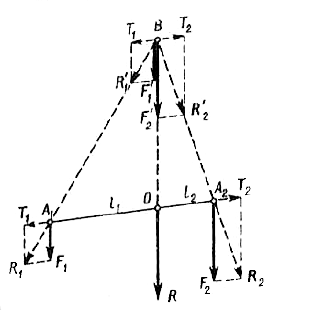Two parallel forces and acting in the same direction are applied to a rigid body.
Porve that
(a) the magnitude of the resultant force is equal to the sum of magnitudes of the forces being added,
(b) the resultant force is parallel to the forces being added and acts in the same direction,
(c ) the resultant force passes through the centre of the parallel forces, i.e. through the point which divides the distance between the points of application of both forces into sections inversely proportional to the magnitude of the forces.
Apply to the body two forces and equal in magnitude and opposite in direction (Fig.).

Adding up the forces , respectively, we obtain two forces intersecting in point B. Translate the forces to this point and resolve them again into the former components. The forces are in equilibrium, but the forces act in the same direction and their resultant force .
The position of point O, the centre of parallel forces, may be found from the similarity of triangles. From the condition
we obtain
from which , which was required to prove.
Similar Questions
Sum of magnitudes of the two forces acting at a point is 16N if their resultant is normal to the smaller forces and has a magnitude 8N then the forces are .
View SolutionSum of magnitudes of the two forces acting at a point is 16N if their resultant is normal to the smaller forces and has a magnitude 8N then the forces are .
View Solution
Knowledge Check
If two equal forces act on the body in opposite direction, then the resultant force on the body will be
AmoreBlessCzeroDnone of theseTwo forces each of magnitude 2N, act at an angle of 60∘. What is the magnitude of the resultant force ?
A√2NB√6NC√8ND√12NTwo forces, with equal magnitude F, act on a body and the magnitude of the resultant force is F3. The angle between the two forces is:
Acos−1(−1718)Bcos−1(−13)Ccos−1(23)Dcos−1(89)
What is the resultant force when two forces act in same direction?
View SolutionTwo forces, each of magnitude F have a resultant of the same magnitude F. The angle between the two forces is
View SolutionTwo forces, each of magnitude F have a resultant of the same magnitude F. The angle between the two forces is
View SolutionFour forces are acting on a body as shown in figure. The magnitude of resultant of the forces is
View SolutionTwo forces, each of magnitude F have a resultant of the same magnitude F. The angle between the two forces is
View Solution

